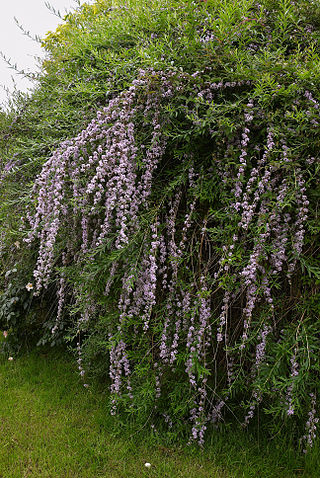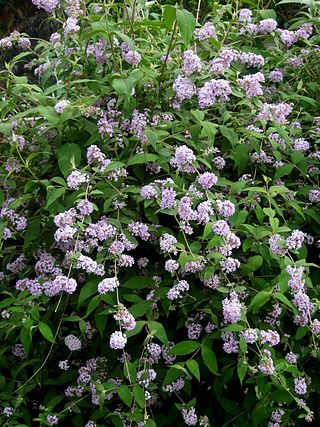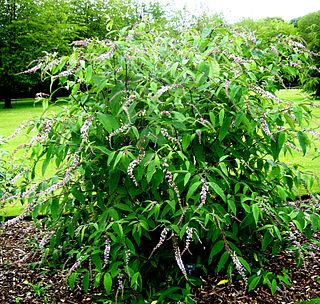
Buddleja is a genus comprising over 140 species of flowering plants endemic to Asia, Africa, and the Americas. The generic name bestowed by Linnaeus posthumously honoured the Reverend Adam Buddle (1662–1715), an English botanist and rector, at the suggestion of Dr. William Houstoun. Houstoun sent the first plants to become known to science as buddleja to England from the Caribbean about 15 years after Buddle's death. Buddleja species, especially Buddleja davidii and interspecific hybrids, are commonly known as butterfly bushes and are frequently cultivated as garden shrubs. Buddleja davidii has become an invasive species in both Europe and North America.

Buddleja davidii, also called summer lilac, butterfly-bush, or orange eye, is a species of flowering plant in the family Scrophulariaceae, native to Sichuan and Hubei provinces in central China, and also Japan. It is widely used as an ornamental plant, and many named varieties are in cultivation. The genus was named Buddleja after Reverend Adam Buddle, an English botanist. The species name davidii honors the French missionary and explorer in China, Father Armand David, who was the first European to report the shrub. It was found near Ichang by Dr Augustine Henry about 1887 and sent to St Petersburg. Another botanist-missionary in China, Jean-André Soulié, sent seed to the French nursery Vilmorin, and B. davidii entered commerce in the 1890s.

Buddleja crispa, the Himalayan butterfly bush, is a deciduous shrub native to Afghanistan, Bhutan, North India, Nepal, Pakistan and China, where it grows on dry river beds, slopes with boulders, exposed cliffs, and in thickets, at elevations of 1400–4300 m. Named by Bentham in 1835, B. crispa was introduced to cultivation in 1850, and came to be considered one of the more attractive species within the genus; it ranked 8th out of 57 species and cultivars in a public poll organized by the Center for Applied Nursery Research (CANR) at the University of Georgia, US. In the UK, B. crispa was accorded the Royal Horticultural Society's Award of Merit in 1961. However, the species is not entirely cold-hardy, and thus its popularity is not as ubiquitous as it might otherwise be.

Buddleja colvilei is endemic to the eastern Himalaya; discovered by Hooker in 1849, he declared it 'the handsomest of all Himalayan shrubs.' In 1896 the species was awarded the RHS First Class Certificate (FCC), given to plants 'of outstanding excellence for exhibition'.

Buddleja alternifolia, known as alternate-leaved butterfly-bush, is a species of flowering plant in the figwort family, which is endemic to Gansu, China. A substantial deciduous shrub growing to 4 metres (13 ft) tall and wide, it bears grey-green leaves and graceful pendent racemes of scented lilac flowers in summer.

Buddleja delavayi is a Chinese species discovered by Forrest in the Tali Range above Dali, Yunnan, in 1910; it is also found in Xizang (Tibet). The species was named for l'Abbé Delavay, the French missionary and plant collector, by Gagnepain in 1912. The shrub is of interest to the botanist because of its unique resting buds and the different types of inflorescence produced through the year.

Buddleja officinalis is a deciduous early-spring flowering shrub native to west Hubei, Sichuan, and Yunnan provinces in China. Discovered in 1875 by Pavel Piasetski, a surgeon in the Russian army, B. officinalis was named and described by Maximowicz in 1880. Introduced to western cultivation in 1908, B. officinalis was accorded the Royal Horticultural Society's Award of Merit three years later, and the Award of Garden Merit in 2002.

Buddleja albiflora is a deciduous shrub native to the mountains of central China, where it grows on shrub-clad slopes at altitudes of between 1,000 and 2,000 m. Named rather carelessly by Hemsley, the species was discovered by Henry, and introduced to western cultivation by Wilson in 1900.

Buddleja forrestii is a deciduous shrub or small tree widely distributed from India to western China. First described by Diels in 1912, he named the species for plant hunter George Forrest, who discovered the plant in Yunnan in 1904 and introduced it to Western cultivation.

Buddleja japonica is a deciduous shrub native to Honshu and Shikoku, Japan, where it grows on mountain slopes amid scrub. The shrub was named and described by Hemsley in 1889, and introduced to Western cultivation in 1896.

Buddleja nivea is a vigorous shrub endemic to western China, evergreen in the wild, but deciduous in cultivation in the UK. The plant was discovered by Wilson in the Yangtze basin at altitudes of 700 – 3,600 m. Introduced to cultivation in 1901, it was named by Duthie in 1905. Several plants similar to the species but originally treated as species and varieties in their own right have now been sunk as B. nivea.
Buddleja yunnanensis is a shrub native to Yunnan and much of the rest of south-western China, where it grows on forest margins, thickets, and along streams at elevations of 1,000 – 2,500 m. The shrub was first described and named by Francois Gagnepain in 1915. This species is distinct from and does not resemble Buddleja nivea var. yunnanensis, although sometimes the latter is erroneously labelled as B. yunnanensis.
Buddleja curviflora is a deciduous shrub native to southern Japan and Taiwan, where it grows in thickets on stony slopes at elevations of 100–300 m. B. curviflora was named and described Hooker and Arnott in 1838. Plants in Taiwan have been described as a separate species Buddleja formosana and assessed as Critically Endangered by IUCN, but the distinction is not recognized by Li and Leeuwenberg, who sank formosana as a synonym.

Buddleja fallowianavar.albaSabourin is a white-flowered variety of B. fallowiana endemic to Yunnan in western China, where it grows in open woodland, along forest edges and watercourses. The shrub was considered superior to the lavender-blue flowered B. fallowiana by Bean, who thought it one of the most attractive of all buddlejas.
Buddleja davidiivar.alba is endemic to central and western China. The plant has also been treated as a form, and a cultivar ('Alba'). However, Anthonius Leeuwenberg sank var. alba and the other five varieties of davidii as synonyms, considering them to be within the natural variation of a species, a treatment also adopted in the Flora of China published in 1996.

Buddleja davidiivar.nanhoensis is endemic to Kansu, China, and introduced by Farrer in 1914. The taxonomy of the plant and the other five davidii varieties has been challenged in recent years. Leeuwenberg sank them all as synonyms, considering them to be within the natural variation of a species, a treatment adopted in the Flora of China published in 1996.
Buddleja davidiivar.magnifica is endemic to much of the same area as the type; it was named by Rehder and E. H. Wilson in 1909.
Buddleja davidiivar.veitchiana was collected in Hubei and introduced to cultivation by E. H. Wilson; it was named for the British nurseryman and horticulturist James Veitch by Rehder. The taxonomy of the plant and the other five davidii varieties has been challenged in recent years. Leeuwenberg sank them all as synonyms, considering them to be within the natural variation of a species, a treatment adopted in the Flora of China published in 1996.
Buddleja davidiivar.wilsonii is endemic to western Hubei, China, at elevations of between 1600 and 2000 m; it was named for the English plant collector Ernest Wilson by Alfred Rehder. The taxonomy of the plant and the other five davidii varieties has been challenged in recent years. Leeuwenberg sank them all as synonyms, considering them to be within the natural variation of a species, a treatment adopted in the Flora of China published in 1996.
Buddleja candida is a small deciduous shrub widely distributed from north-east India through south east Xizang (Tibet) to the provinces of Sichuan and Yunnan in western China, growing on forest edges, in mountain thickets, and along riverbanks, at altitudes of 1000 – 2500 m. Named and described by Dunn in 1920, the shrub was introduced to cultivation in the west in 1928.















